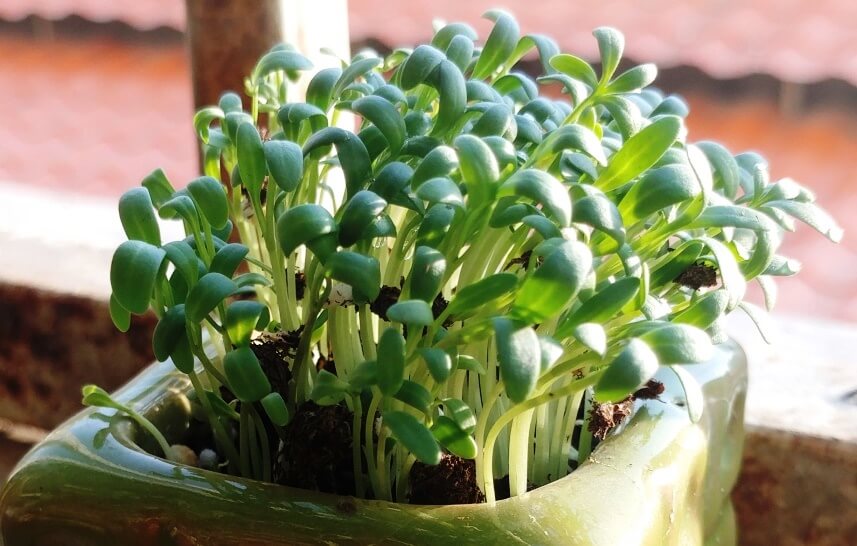Microgreens are a new and exciting topic within the indoor gardening world. In general, microgreens are the edible stems and leaves of herbs, vegetables, and some flowers. They are often planted close together in the soil and harvested when they are young, usually within one to two weeks after germination. Different types of microgreens can be cultivated at home, but this article will focus on the top 5 best microgreens to grow indoors.
If Like to know more about microgreens, check these articles:
<<What Are Microgreens >> and <<Health Benefits Of Microgreens>>
Top 5 best microgreens to grow indoors
Arugula microgreens
The spicy flavor and lovely heart-shaped leaf of arugula make it one of the most common types of microgreens for kids and family gardening. This microgreen is terrific on its own or as the base of a mix. The strong, recognizable flavor of arugula makes it an excellent addition to many salad combinations. In addition, its fast germination and growth rates make it an easy microgreen to grow for almost anyone.
Arugula microgreens germinate in two to three days and can be harvested five to seven days following germination. It can germinate in temperatures as low as 40 degrees Fahrenheit. Because arugula’s slender stem makes it more likely to fall when watered, you should water them by spraying and gently brushing them back up if they fall.
Arugula microgreens
Basil microgreens
The second plant on our list of the top 5 microgreens for kids is micro basil. Green basil microgreens give a distinctive basil flavor. It adds a lovely touch to various recipes and can even be used in desserts. Purple basil can also be used alone or combined with green basil to delight the eyes and the palate. Once you have mastered some of the challenges of cultivating basil microgreens, you will discover that it can transform even the most ordinary dishes into extraordinary platters.
Basil takes four to five days to germinate. Since basil microgreens grow slowly, they can be harvested approximately fourteen to twenty days after germination. Basil needs consistently warm temperatures; thus, we must cultivate it in a warm environment. It is a sensitive plant and it will blacken if cleaned and stored in cold conditions. If you are going to use basil microgreens right away, a fast rinse will not damage the leaves.
Basil microgreens
Radish microgreens
Radish microgreens are one of the types of microgreens that are distinguished for how easy and fast they grow in the garden. They do not need much care and constantly perform well indoors, which is why they are among the top 5 microgreens for kids and families to grow indoors.
Radish microgreens germinate in two to three days and are harvested after six to eight days. When harvested at the right time, radish microgreens stay soft and have a bright stem color.
Radish microgreens
Beetroot (beet) microgreens
The vivid red and purple stem of the beet is noticeable. It is one of the top 5 microgreens as it is gorgeous as a single crop or as a vibrant accent in any mix. Bull’s Blood is the best-known of the beet varieties and is one of the most expensive variants. This variant produces a brightly colored stem with a lovely green hue. The Ruby Queen variant is also a good choice and more cost-effective than Bull’s Blood.
In four to eight days, beet microgreens germinate. You should keep your beets at a consistent temperature for optimal germination. Another point about beetroot microgreens is that overwatering them will cause the beetroot microgreens to rot, so avoid keeping the soil too moist following germination.
Beet microgreens
Garden Cress microgreens
The garden cress is ranked fifth among the top 5 best microgreens to grow indoors. It is one of the spicy types of microgreens which gives a unique flavor to wraps, salads, and sandwiches. Although keeping it fresh and bright is difficult, it is a beautiful addition to home foods. It is best not to use it in a mix because it will decay faster than the other ingredients.
Garden cress is a form of microgreen that grows quickly. It takes two to three days to germinate. Since cress microgreens have a fast growth rate, they can be harvested eight to ten days after germination. Micro cress is a light plant, so you should sow it thickly for higher yields. Cress has a short shelf life due to its delicate nature and, if left to grow, it might pass the desired growth peak and start to yellow and rot. When storing garden cress microgreens, use an airtight container to avoid quick degradation.
Cress microgreens
Conclusion
The world of microgreens is enormous. Nowadays, there are different types of microgreens available. Choosing the top 5 microgreens is a difficult challenge. This article has covered some of the most exciting and easy-growing microgreens for kids’ and families’ indoor gardening.










